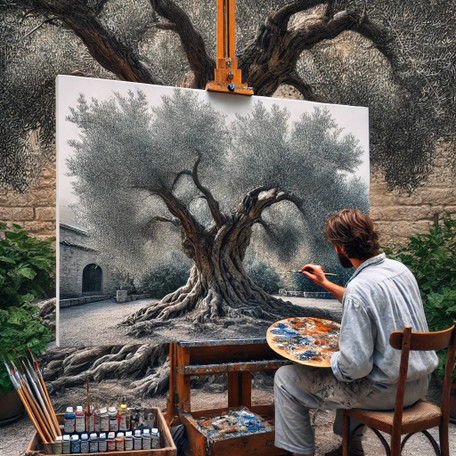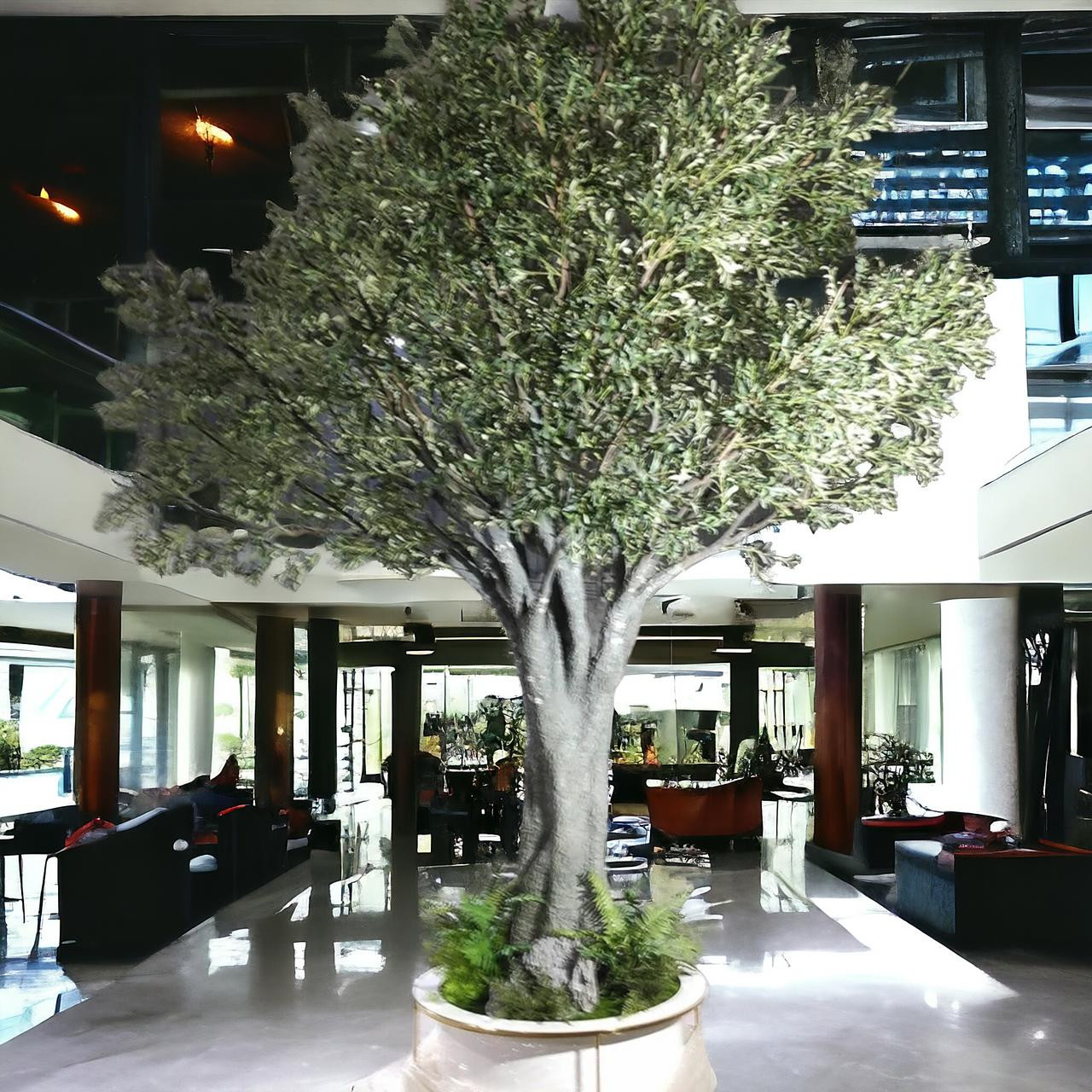Olive Trees in Art and Literature: A Symbol of Peace and Prosperity
10th Aug 2024
Olive Trees in Art and Literature: A Symbol of Peace and Prosperity
The olive tree, with its gnarled branches and silvery leaves, has been a symbol of peace, wisdom, and longevity for thousands of years. This ancient tree, native to the Mediterranean region, has found a revered place in art, literature, and religious texts across cultures. Its presence in these domains reflects not only its agricultural and economic importance but also its deep spiritual and philosophical significance. This blog post delves into how olive trees have been depicted in art, literature, and religious texts, exploring their symbolic meanings and the timeless messages they convey.
The Olive Tree in Religious Texts: A Covenant of Peace
One of the most profound early references to the olive tree is found in the Bible, where it is closely associated with peace and reconciliation. In the story of Noah's Ark, a dove returns to Noah with an olive leaf in its beak, signaling the end of God's wrath and the beginning of a new covenant between God and humanity (Genesis 8:11). This moment is one of the earliest and most enduring symbols of peace in Western religious and cultural traditions. The olive branch, as a result, has become synonymous with peace and the cessation of hostilities.
In Christianity, the olive tree is also significant in the Garden of Gethsemane, where Jesus prayed before his crucifixion. The name Gethsemane itself is derived from the Aramaic word for “olive press,” symbolizing the weight of the suffering Jesus was about to endure. The olive tree here represents endurance, spiritual struggle, and ultimately, redemption.
In Islam, the olive tree is mentioned in the Quran as a blessed tree, symbolizing light and wisdom. The Quran refers to the olive tree as "neither of the east nor of the west," highlighting its universality and its connection to divine light (Surah An-Nur 24:35). This portrayal underscores the tree's status as a symbol of knowledge, guidance, and the sustaining of life.
Olive Trees in Literature: A Symbol of Wisdom and Longevity
The olive tree's representation in literature is as rich and varied as its religious symbolism. Ancient Greek literature, for instance, is replete with references to the olive tree, often symbolizing wisdom and victory. In Homer's "Odyssey," the hero Odysseus constructs his bed from the trunk of an olive tree, signifying the strength and endurance of his marriage to Penelope. The olive tree here is a symbol of enduring love, stability, and the unbreakable bond between husband and wife.
The olive also appears in Greek mythology as a gift from the goddess Athena to the city of Athens. According to the myth, Athena and Poseidon competed for the patronage of the city, and the citizens chose Athena's gift of the olive tree over Poseidon's gift of a saltwater spring. The olive tree was seen as more valuable because it provided food, oil, and wood, all essential for the prosperity of the city. This myth illustrates the tree's association with wisdom, civilization, and the flourishing of human society.
In modern literature, the olive tree continues to symbolize endurance, resilience, and the connection between people and the land. In Gabriel García Márquez's "One Hundred Years of Solitude," the olive tree is a symbol of the Buendía family's endurance and the cyclical nature of history. Similarly, in the poetry of Pablo Neruda, olive trees are often evoked to symbolize the connection between humanity and the earth, as well as the endurance of life in the face of hardship.
Olive Trees in Art: A Symbol of Life and Peace
Artists throughout history have been captivated by the olive tree, using it to convey themes of peace, resilience, and the beauty of the natural world. One of the most famous depictions of olive trees in art is found in the works of Vincent van Gogh. During his stay at the Saint-Paul-de-Mausole asylum in Saint-Rémy-de-Provence, van Gogh created a series of paintings featuring olive trees. These works, characterized by their swirling, expressive brushstrokes, convey the artist's deep connection to nature and his search for peace amid his inner turmoil.
Van Gogh's olive trees are not just representations of the landscape; they are imbued with a sense of spiritual significance. The twisted trunks and vibrant foliage seem to pulse with life, reflecting van Gogh's belief in the enduring power of nature. The artist himself wrote about the symbolic meaning of olive trees, describing them as "symbolic of the sacred" and "full of a mysterious life."
In addition to van Gogh, other artists have also used the olive tree as a symbol of peace and resilience. For example, Pablo Picasso's "Dove with Olive Branch," created in 1949, became an iconic image of peace. The simple yet powerful drawing of a white dove holding an olive branch in its beak was used as a symbol of the peace movement after World War II, and it continues to be associated with peace and reconciliation efforts worldwide.
The olive tree's portrayal in art is not limited to the Western world. In the Middle East, olive trees are often depicted in art as symbols of Palestinian identity and resistance. The tree represents the deep connection of the Palestinian people to their land, as well as their resilience in the face of displacement and conflict. This symbolism is poignantly captured in the works of Palestinian artists, who use the image of the olive tree to express themes of loss, memory, and hope for the future.
The Olive Tree: A Universal Symbol
The olive tree's enduring presence in religious texts, literature, and art underscores its status as a universal symbol of peace, wisdom, and longevity. Its significance transcends cultural and religious boundaries, making it a powerful symbol of the human experience.
The tree's association with peace is perhaps its most widely recognized symbolism. The image of the olive branch, extended as a gesture of peace, is one that resonates across cultures and continues to be relevant in contemporary times. This symbolism is rooted in the tree's long history and its role in human civilization as a source of sustenance and prosperity.
In addition to peace, the olive tree symbolizes wisdom, particularly in the context of ancient Greece. The tree's connection to Athena, the goddess of wisdom, and its role in Greek mythology highlight its association with knowledge, civilization, and the flourishing of society. This symbolism has carried through to modern times, where the olive tree continues to be seen as a symbol of enduring wisdom and the continuity of life.
The olive tree's symbolism of longevity is also significant. Olive trees are known for their long lifespans, with some trees in the Mediterranean region estimated to be over a thousand years old. This remarkable endurance makes the olive tree a symbol of resilience, continuity, and the enduring nature of life. It is a reminder of the deep connection between humanity and the natural world, and the ways in which we are sustained by the earth's resources.
Conclusion
The olive tree, with its rich history and deep symbolism, is more than just a tree; it is a powerful symbol of peace, wisdom, and longevity that has resonated across cultures and through the ages. In religious texts, it represents a covenant of peace and divine light. In literature, it symbolizes wisdom, resilience, and the enduring connection between people and the land. In art, it captures the beauty and power of the natural world, as well as the hope for peace and reconciliation.
As we continue to face global challenges and seek ways to live in harmony with each other and with the earth, the olive tree remains a potent symbol of the values we hold dear. Its presence in our cultural and spiritual heritage serves as a reminder of the enduring power of peace, the importance of wisdom, and the resilience of life.




